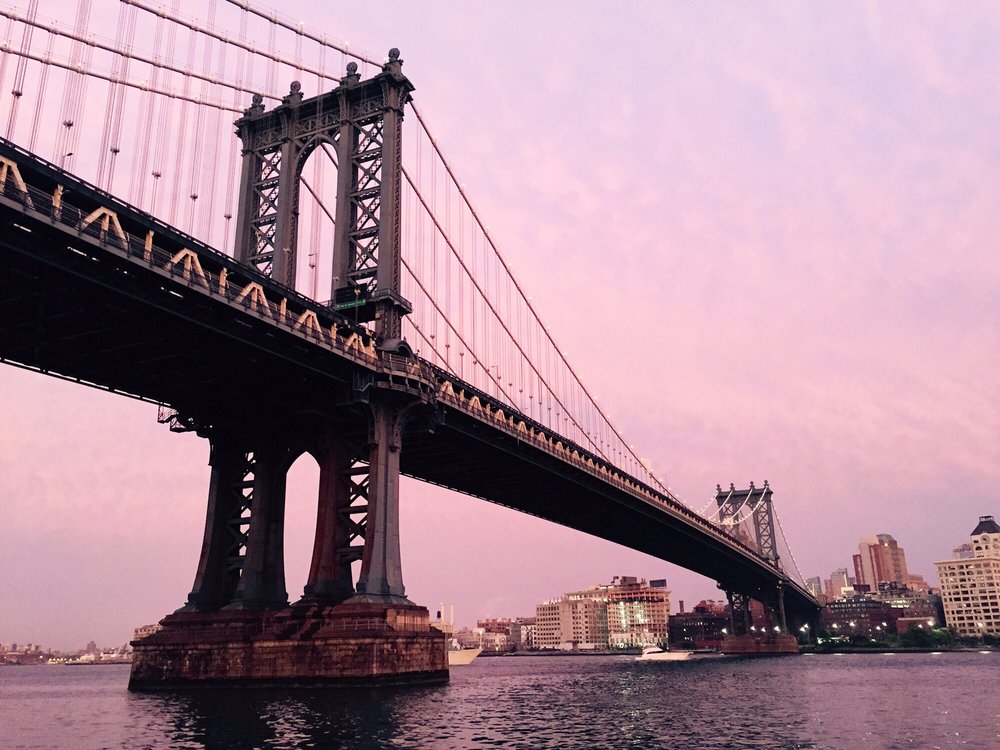
(Photo by Austin Mann Photography)
It’s easy to believe that the neighborhood, Dumbo, was coined by developers who wanted a cool sounding acronym like SoHo, NoHo, or Tribeca. But in fact, Dumbo was named by residents and artist loft tenants in the late 1970s who were looking for an uncool, anti-marketing name to protect their turf from developers who they thought were going to ruin the character of the neighborhood. Some things never change. After DumboNYC wrote an article titled Dumbo, the Historic District With the Modern Name, a long time resident sent an email and introduced me to Crane Davis.
Crane Davis is a writer and producer who lived on Washington Street in Dumbo from 1976 through 2006. In the 1980’s, he served as president of the Fulton Ferry Local Development Corporation. He recently retired to a home in the Hudson Valley near Woodstock. Crane is today’s guest writer. He lets us in on what the area now known as Dumbo used to be, and how he and a few others named Dumbo.
Click below to read Crane’s story.
Related article: What Does Dumbo Stand For, Revisited
HOW DUMBO GOT ITS NAME
In 1976, when I moved into the neighborhood now known as “DUMBO,” the people in the 40 blocks bounded by Fulton Street, the BQE and the Navy Yard seemed to have little in common.
- At the south end stood Fulton Landing, with the River Cafe, a small maritime museum, Olga’s Barge and a handful of residents and merchants at the base of Fulton Street who were concerned primarily with traffic issues.
- At the north end stood the Farragut Housing Project, the Admiral’s House for the Navy Yard, and Vinegar Hill: a community of small houses that were disappearing, one by one, into the expansion plans of Con Edison.
- In between was Two Bridges, a 30-block manufacturing area in the shadow of the Manhattan and Brooklyn Bridges, centered on the Gair Buildings: huge reinforced concrete buildings that once housed the corrugated cardboard empire of Robert Gair. Scattered among the manufacturers were a handful of three story residential walk-ups and “mixed-use” buildings: with manufacturers on the lower floors and “illegal” loft tenants, like myself, living on the top. These early loft tenants would play a major role in naming “DUMBO.”
In the late 60’s and early 70’s, the administration of Mayor John Lindsay had become aware of two issues:
- The owners of certain manufacturing buildings were having trouble attracting tenants. They were six-story-high ‘mill-construction’ buildings with brick walls, wooden floors and a small, on-street loading dock, built in the late 1800’s. Few manufacturers in 1975 wanted to be on the top floors, where they would be heavily dependent on a single, shared elevator to move goods in and out. Despite low rents, top floors emptied out, leaving many buildings with 70% occupancy, or less.
- At the same time, the Lindsay administration was trying to take advantage of any asset it could find that hadn’t already fled to the suburbs. One of those assets was a seemingly endless stream of artists, bohemians, entrepreneurs and others who would trade low rent for incredibly poor living conditions, just to be in New York City.
The result was the “Artist In Residence” program. In building after building in Lower Manhattan, the top floors became “Live/Work spaces,” with an official maximum of three units of “Certified Artists” (as designated by the City) paying the going rate for manufacturing space. The result was a win-win: Building owners got tenants who filled empty space, paid the going rate and didn’t compete for the elevator… while tenants got cheap living/working space.
Needless to say, it was too good to be true. Building owners with 3 live/work tenants on the top floor soon filled their other empty floors with additional tenants… and neither owners nor tenants paid much attention to “artist certification.” Soon, the top floors filled with not just painters and sculptors, but with dancers and writers and even a handful of bankers, lawyers, teachers and salespeople… the very dregs of humanity.
“Loft space” meant something very different in those days. It was literally raw manufacturing space: unsanded floors, asbestos-wrapped pipes, lead-painted walls. The first night I slept in my new loft space, there was not a door that could be locked between my mattress on the sixth floor and the sidewalk of Washington Street below. What we lacked in capital, we made up for in energy: sheet-rocking entire floors in total ignorance of construction codes. Even more important, we knew how to throw great parties in big spaces, marking major events like a new toilet, painted walls or the birth of a child.
In Manhattan, however, things began to turn ugly as landlords began to flip loft units. Once the sheetrock was up and the toilets were in, the landlord would discover, much to his shock and dismay, that the tenant in question was not, in fact, a “certified artist” or that the unit in question exceeded the legally permissible three “live/work” units per building. The tenant would be evicted, and several weeks later the same unit would be listed once again, but at a significantly higher rent. The landlord was, in effect, renting the ‘fixtures’ that had been installed by the previous tenant. Finally, the courts required the State and City to come up with legislation intended to resolve the underlying issues of mixed-use buildings.
By 1978, there were approximately 150 loft tenants living in 50 “live/work” units, in seven buildings scattered across the Two Bridges neighborhood. They were very active in the development of that “Loft Law,” and benefited greatly from the fact that residential development of the Brooklyn waterfront, ran several years behind development in Manhattan. As a result, the underlying communities benefited from experience of SOHO, NOHO, Tribeca and even South Street – and we were much better organized by the time serious development pressures began.
In February of 1981, working with New York City Planning, local residents from Vinegar Hill, Two Bridges and Fulton Landing completed a door-to-door survey of the owners and tenants in every square foot of the 40-block area. That survey revealed that manufacturing was alive and well in Two Bridges: the available manufacturing space was over 95% occupied, providing over 5000 jobs, predominantly for minority women in the unionized needle trades.
In later years, writers in the real estate sections would describe the vision required to convert “gritty, noirish DUMBO’s “vacant factories” into residences. In fact, it took far more vision and time to come up with a plan that would save many of the manufacturing jobs and allow development of the neighborhood…. which was finally accomplished in a brokered resolution involving input from the State, City, developer and the local community.
Oh, and the name “DUMBO?” in 1978, as the inevitability of development became apparent, the community decided that, if we were to die, at least we should be buried under a name of our choosing. A naming committee consisting of Selby Beebe, Crane Davis, Monte Davis and John Donovan was appointed. After much sitting around and drinking beer, to a point where none of us could remember who had suggested what, we came up with two alternatives:
- DUMBO: Down Under the Manhattan Bridge Overpass
- DANYA: District Around the Navy Yard Annex
The choice was presented to the community at a huge loft party and the results weren’t even close. It was DUMBO by a landslide. Everyone agreed that it had just the right kind of Dadaist anti-marketing positioning to protect our turf from developers: who, after all, would spend a million dollars for a loft in a place called DUMBO?
Who, indeed.
Crane Davis
craned@hvc.rr.com
Read NY Times articles on Crane Davis and the Brooklyn Loft Tenants organization:
- Prospects Appear Dark For Two Measures to Protect City’s Loft Residents, 25Jun1981, NY Times
- Fulton Ferry Revival: A Clash of Ideas, 31Oct1982, NY Times
- City Scrutinizing Lofts in Brooklyn, 18Nov1984, NY Times
[Thank you Carol Sun for the introduction.]






Interesting piece. David Walentas is always credited with coining the name DUMBO, but it’s the artist that came up with it… nice to know. On the other hand, it seems like Walentas has been getting a bad wrap lately but after reading the NY Times article from 1982, I think he deserves whatever success that has come his way. He had a vision, stuck with it, and now over 25 years later it’s come to pass.
Thanks to Crane et al for the wonderfully goofy name. Hopefully DUMBO will continue to be an artist haven even as the neighborhood continues to evolve.
Pingback: 110 Livingston News & Blog » Recommended Reading: Local Lore Edition
“A fascinating story on the development of DUMBO and how the neighborhood came about its name. It was conceived by a group of drunken writers and artists one night as a way to make the area seem unattractive or embarrassing to people looking to buy million-dollar residences there.”
http://www.gothamist.com/2007/05/21/extra_extra_523.php
More accurately, the artists were the first wave of gentrification who still proudly reminisce about their role in naming/taming the frontier. Yuppies collect art… and they didn’t move here to be near the “minority women in the unionized needle trades.” They followed the-fresh-from-private-art-school-artists. Instead of complaining about developers and knocking the yuppies, they should position themselves better in the process, because they are a part of it even if this notion does not appeal to their vanity… and that’s coming from an artist who’s been in Brooklyn since 1988.
Pingback: Edward Champion’s Return of the Reluctant » Window on Main Street
I also love the {unofficial} name for one of the ajacent nabourhods: RAMBO – Right After the Manhattan Bridge Overpass
Pingback: Dumbo NYC, Brooklyn » Archive » Dumbo, the Historic District With the Modern Name (DumboNYC.com)
Pingback: Dumbo NYC, Brooklyn » Archive » What Does the Acronym DUMBO Stand For? (DumboNYC.com)
Pingback: Piano`s & DUMBO « Serg en Ciudad Gótica
Pingback: Dumbo NYC, Brooklyn » Archive » Dumbo’s New/Old Identity (DumboNYC.com)
Pingback: Dumbo NYC, Brooklyn » Archive » Dumbo Top Ten in 2007 (DumboNYC.com)
Pingback: DUMBO (Grimaldi’s Pizza and the Brooklyn Ice Cream Factory) « New York City in 60 Seconds
Pingback: What landmarks/streets/prepositions are in a name? « Daily Design Idea
Pingback: Dumbo NYC, Brooklyn » Archive » You Won’t See One of These for Dumbo (DumboNYC.com)
Pingback: DUMBO in Brooklyn, NY is Home to Growing Digital Media Industry
Pingback: Dumbo NYC, Brooklyn » Archive » Chumbo is Dumbo in Chinatown? (DumboNYC.com)
Thanks for ‘reprinting’ this history – filled some gaps.
When I arrived here in ’84 Walentas had proposed his mega interbridge development project and was to name it ‘Fulton Landing’ ( I still have a poster for it). The plan seemed very appealing at the time (there was no BB Park plan then. I remember that local FFL residents objected to his choice of names. We were told that Walentas objected to the name DUMBO. Can anyone shed more light on this?
Mentioned in the article in NY Times: Dumbo, Brooklyn: How Noir Looks When It’s Polished
http://www.nytimes.com/2013/09/01/realestate/dumbo-brooklyn-how-noir-looks-when-its-polished.html?pagewanted=all
“Neighborhood lore, at least as related by an oft-cited local history, has it that “Dumbo,” an acronym for Down Under the Manhattan Bridge Overpass, was coined in the late 1970s by a few artists hoping that an odd name would deter development. So much for that effort (detailed on DumboNYC.com).”
Pingback: Tour Review: The New York Times Journeys and Urban Adventures – Dumbo, the New Brooklyn | buildingmybento